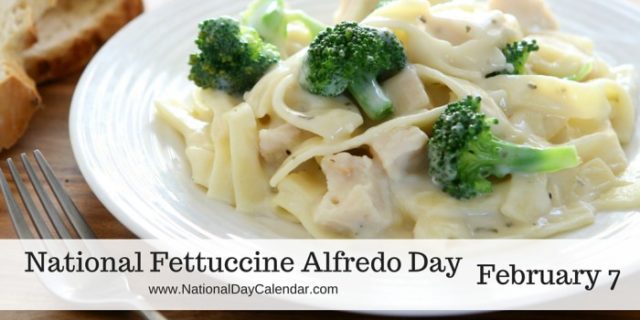
National Fettuccine Alfredo Day is observed annually on February 7th.
Alfredo di Lelio, an Italian restaurateur, created Fettuccine Alfredo in 1908. After his wife had given birth to their first son that year, she did not have an appetite. To help encourage her to eat, he created a dish of noodles, cheese and butter. She liked the dish so much that she thought he should put it on the menu at his small restaurant in Rome. Everyone around the world has been enjoying this dish ever since. Today it is one of the most popular pasta dishes in America.
- Fettuccine is a flat thick noodle made of flour and egg.(literally meaning “little ribbons” in Italian)
- The original recipe for Fettuccine “Alfredo” is pasta made from fettuccine noodles tossed with one part Parmesan cheese and 3 parts butter. Alfredo sauce is the emulsified liquids that form the smooth and rich coating on the pasta.
- Douglas Fairbanks and Mary Pickford, early movie stars, fell in love with the dish while on their honeymoon in 1920. This helped to make the dish and Alfredo world famous.
- There are authentic “Alfredo’s” restaurants in the US, Alfredo’s at Rockefeller Center in New York City is the most well known.
- Fettuccine Alfredo is commonly served in the United States as a main dish. In Italy, a pasta course is typically served before the main dish, in an appetizer portion.
- When meat and peas are added to Fettuccine Alfredo, the dish is called Hay and Straw.
- In the jarred Alfredo sauce available in supermarkets, the sauce is thickened with starch and not with cheese.
- The International Pasta Organization claims that if Italians ate their average yearly amount of pasta in spaghetti shape (rather than the numerous other varieties of pasta shapes), they would eat approximately 600 million kilometres of spaghetti — enough noodles to wrap around the planet 15,000 times.
Sources:












